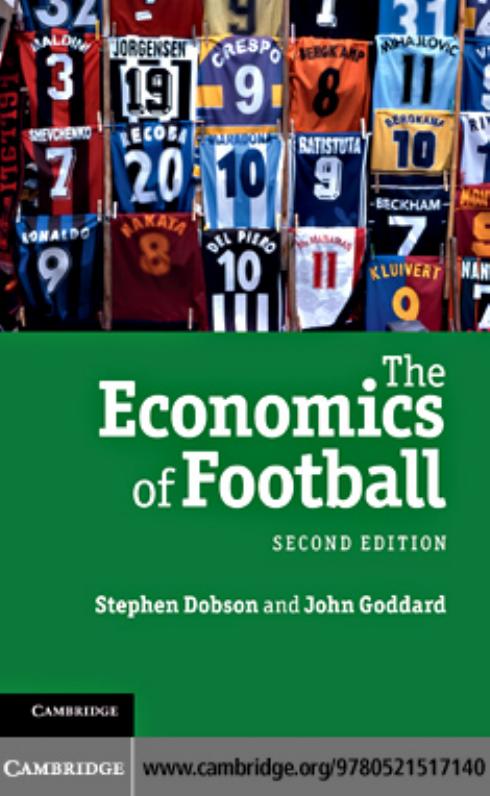The Economics of Football 2nd Edition by Stephen Dobson, John Goddard ISBN 9780511985652 0511985657
$70.00 Original price was: $70.00.$35.00Current price is: $35.00.
Instant download Economics of Football 2nd Edition The after payment
The Economics of Football 2nd Edition by Stephen Dobson, John Goddard – Ebook PDF Instant Download/Delivery: 9780511985652 ,0511985657
Full dowload The Economics of Football 2nd Edition after payment
Product details:
ISBN 10: 0511985657
ISBN 13: 9780511985652
Author: Stephen Dobson, John Goddard
The second edition of this popular book presents a detailed economic analysis of professional football at club level, with new material included to reflect the development of the economics of professional football over the past ten years. Using a combination of economic reasoning and statistical and econometric analysis, the authors build upon the successes and strengths of the first edition to guide readers through the economic complexities and peculiarities of English club football. It uses a wide range of international comparisons to help emphasize both the broader relevance as well as the unique characteristics of the English experience. Topics covered include some of the most hotly debated issues currently surrounding professional football, including player salaries, the effects of management on team performance, betting on football, racial discrimination and the performance of football referees. This edition also features new chapters on the economics of international football, including the World Cup.
The Economics of Football 2nd Edition Table of contents:
1 Introduction
1.1 The economics of professional team sports: three seminal contributions
1.2 Outline of this volume
Notes
2 The economic theory of professional sports leagues
Introduction
2.1 The North American professional team sports model
2.2 A model of an n-team league
The n-team closed model
The n-team open model
2.3 A model of a two-team league
The two-team closed model
The two-team open model
2.4 Revenue sharing
Revenue sharing in the closed model
Revenue sharing in the open model
The Szymanski-Késenne revenue-sharing analysis
2.5 Restraints on expenditure on players’ salaries
Luxury tax: a tax on salary expenditure over a set threshold
Payroll cap: a limit on each team’s total salary expenditure as a percentage of the average team
G14 payroll cap: constraint on the ratio of each team’s salary expenditure to its own revenue
Conclusion
Notes
3 Competitive balance, uncertainty of outcome and home-field advantage
Introduction
3.1 Measuring competitive balance and competitive inequality
3.2 Home-field advantage
3.3 Distributional properties of the goals scored by the home and away teams
3.4 Good and poor sequences, and persistence in football match results
Conclusion
Notes
4 Forecasting models for football match results
Introduction
4.1 Previous literature on modelling and forecasting match results in football
4.2 A goals-based forecasting model
4.3 Probabilistic forecasts for match results in ‘scores’ format
Calculation of the numerical values of the model’s covariates
Calculation of the mathematical expectations of the goals scored by the home and away teams
Conversion of expectations of goals scored into match result probabilities
4.4 A results-based forecasting model
4.5 Probabilistic forecasts for match results in ‘win-draw-lose’ format
4.6 Evaluation of the goals-based and results-based forecasting models
Conclusion
Notes
5 Game theory and football games
Introduction
5.1 The penalty kick
5.2 A game-theoretic model of in-play strategic choice for football teams
5.3 The timings of player dismissals and goals
5.4 An empirical model for the in-play arrival rates of player dismissals and goals
5.5 Estimation results and interpretation
Empirical arrival rates for player dismissals
Empirical arrival rates for goals scored
5.6 Stochastic simulations for in-play match result probabilities conditional on the current state o
Conclusion
Notes
6 English professional football: historical development and commercial structure
Introduction
6.1 English professional football: competitive structure and team performance
Origins and competitive structure
Team performance
6.2 Match attendances
Trends in attendances
Explanations for changes in attendances
6.3 Financial structure of English football: overview of profit and loss accounts
6.4 Gate revenues and admission prices
6.5 Broadcast revenues
The early history of football on television
Televised football during the era of pay-TV
Implications for competition and welfare
6.6 Football’s labour market: players’ salaries and the transfer system
6.7 Ownership, governance and finance
Conclusion
Notes
7 Determinants of professional footballers’ salaries
Introduction
7.1 The compensation of professional footballers
7.2 The economics of superstars
7.3 Rank-order tournaments and intra-team earnings distributions
7.4 Determinants of players’ compensation: empirical evidence
Football players’ salaries
Salaries in North American major league sports
Conclusion
Notes
8 Professional footballers: employment patterns and racial discrimination
Introduction
8.1 Employment mobility, migration and career structure in English football
8.2 International migration of professional footballers
8.3 Racial discrimination in professional team sports
Empirical evidence on racial discrimination: North American professional team sports
Empirical evidence on racial discrimination: English and European football
Conclusion
Notes
9 The football manager
Introduction
9.1 The role of the football manager
9.2 Measuring the managerial contribution: the production frontier approach
9.3 Patterns of managerial change in English football
9.4 Determinants of managerial change
9.5 Estimation of hazard functions for managerial departure
9.6 The effect of managerial change on team performance
9.7 Managerial succession effects in English football
Conclusion
Notes
10 The football referee
Introduction
10.1 The role of the football referee
10.2 Favouritism and referee behaviour
10.3 The incidence of disciplinary sanction in English Premier League football
Relative team quality and home-field advantage
Importance of the match for end-of-season outcomes
Individual teams and managerial spells
Individual referees
Time consistency of players’ behaviour and refereeing
Match attendance
Conclusion
Notes
11 Spectator demand for football
Introduction
11.1 Econometric analysis of football attendances
Measuring the demand for football attendance
Demographic and geographic determinants of attendance
Price, income and unemployment
Team quality and uncertainty of outcome
Live TV broadcasts, stadium attendances and TV audiences
Other influences on attendance
11.2 Modelling the demand for attendance at English league football, 1947–1997
11.3 Explaining base attendances, and the loyalty, league position, price and goals scored coefficie
Conclusion
Notes
12 Gambling on football
Introduction
12.1 Previous evidence on the informational efficiency of football and other sports betting markets
Betting market efficiency and the favourite-longshot bias
Efficiency of betting markets in North American professional team sports
Informational efficiency of football betting markets
Online betting exchanges and person-to-person betting
Football spread betting
Sentiment bias in betting markets
12.2 A forecasting model for half-time/full-time match outcomes
12.3 Comparing the model’s probabilistic forecasts with betting odds
12.4 Testing the informational efficiency of the half-time/full-time fixed-odds betting market
Conclusion
Notes
13 Football around the world: France, Germany, Brazil, Japan and China
Introduction
13.1 France
13.2 Germany
13.3 Brazil
13.4 Japan
13.5 China
Conclusion
Notes
14 The economics of the World Cup
Introduction
14.1 The World Cup
14.2 Costs and benefits of hosting a mega sporting event
14.3 Prospective economic impact studies
14.4 Retrospective economic impact studies
14.5 Intangible benefits of mega events
Conclusion
Notes
References
Index
People also search for The Economics of Football 2nd Edition:
economics of american football
economics of college football
economics 2nd paper 2nd chapter
a football game between the thunder and the sharks
the economics of college football

 Deep Learning in Computer Vision Principles and Applications Mahmoud Hassaballah & Ali Ismail Awad
Deep Learning in Computer Vision Principles and Applications Mahmoud Hassaballah & Ali Ismail Awad 
